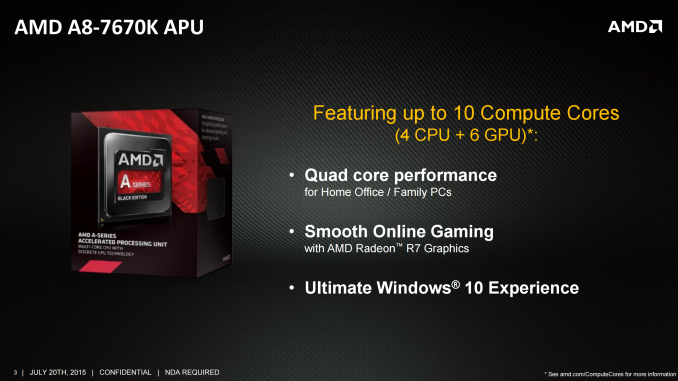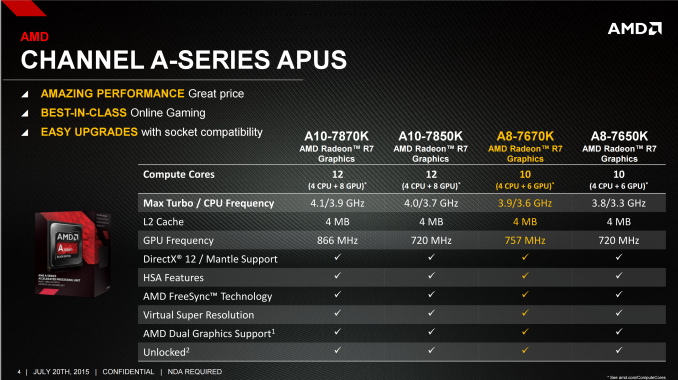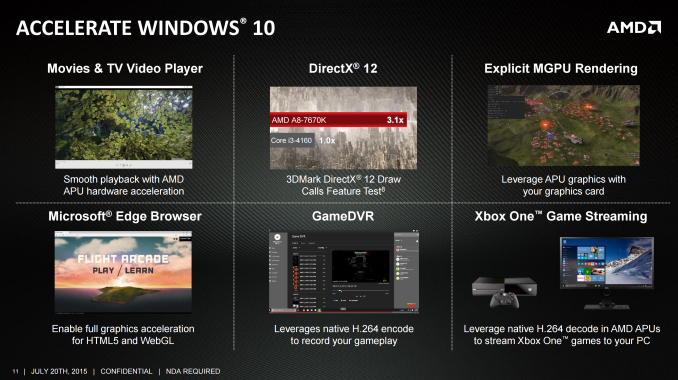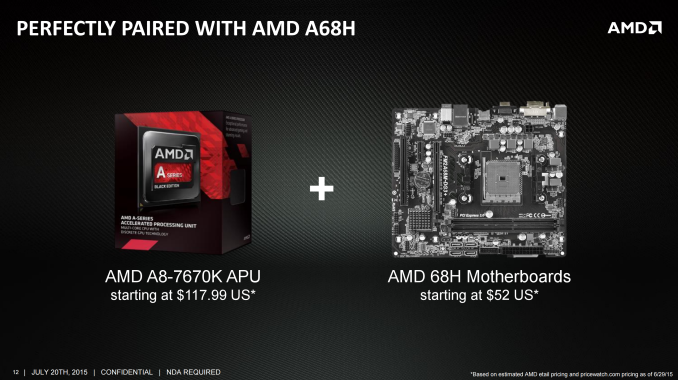AMD Launches the A8-7670K: Filling in the Gaps
by Ian Cutress on July 20, 2015 5:40 PM EST
AMD and Intel, in the last few years, have taken different approaches to how many CPUs enter the mainstream line of the market. Intel has historically had a large product stack, with processors at almost every frequency varying by 100 MHz and slowly rising in core count as well as cache and integrated graphics. AMD’s approach on the other hand is to release a handful of new models every quarter, initially covering the bases on day one and slowing updating the mid points (as well as new high end models) as a lithography node improves in yield and performance and the design matures. We recently took a look at the last launch, the AMD A10-7870K, as well as one at the beginning of the year in the shape of the A8-7650K. The A10-7870K was the first in a line known as the Kaveri Refresh models, or as per AMD’s internal codename ‘Godavari’. The A8-7670K is the second iteration of this line.
The Kaveri Refresh line, or so we are told, is a result of an improved production methodology for better frequency/voltage characteristics and better binning. In the case of the A10-7870K, we were told that the CPU has a minor +0.05 volt increase in the average stock voltage to account for the extra frequency, but due to the improvements the TDP remained the same (95W). In this circumstance, AMD improves on the A8-7650K with an extra 300 MHz to the base frequency (usually the main TDP killer) and an extra 100 MHz on the turbo. This is combined with a 37 MHz increase in the graphics side of the equation, again within the same TDP.
We covered a lot in the A10-7870K review which also applies here to the A8-7670K, although the A8 follows the other A8 APUs by having six compute units for the graphics, or 384 SPs. As AMD does not have a new mainstream desktop APU launch for Windows 10, the current stack of Kaveri and Kaveri Refresh APUs are going to be the focus for AMD, especially with back-to-school sales late in the summer. As a result, a good portion of the press release for the A8-7670K revolves around the use of AMD’s GCN architecture and its alignment to AMD’s mainstream graphics cards, allowing any software that is accelerated by one to be accelerated by the other. As shown above, this includes video playback, DirectX 12, accelerated video encoding and streaming as well.
| AMD Kaveri Lineup | ||||||||
| A10- 7870K |
A10- 7850K |
A10- 7800 |
A10- 7700K |
A8- 7670K |
A8- 7650K |
A8- 7600 |
X4 860K |
|
| Price | $137 | $134 | $131 | $120 | $118 | $104 | $89 | $85 |
| Modules | 2 | 2 | 2 | 2 | 2 | 2 | 2 | 2 |
| Threads | 4 | 4 | 4 | 4 | 4 | 4 | 4 | 4 |
| Core Freq. (GHz) | 3.9-4.1 | 3.7-4.0 | 3.5-3.9 | 3.4-3.8 | 3.6-3.9 | 3.3-3.8 | 3.1-3.8 | 3.7-4.0 |
| Compute Units | 4+8 | 4+8 | 4+8 | 4+6 | 4+6 | 4+6 | 4+6 | 4+0 |
| Streaming Processors |
512 | 512 | 512 | 384 | 384 | 384 | 384 | N/A |
| IGP Freq. (MHz) | 866 | 720 | 720 | 720 | 754 | 720 | 720 | N/A |
| TDP | 95W | 95W | 65W | 95W | 95W | 95W | 65W | 95W |
| DRAM Frequency |
2133 | 2133 | 2133 | 2133 | 2133 | 2133 | 2133 | 1866 |
| L2 Cache | 2x2MB | 2x2MB | 2x2MB | 2x2MB | 2x2MB | 2x2MB | 2x2MB | 2x2MB |
AMD’s marketing slides position the A8-7670K at $118 MSRP against the i3-4160 at $120 – and as a result we see benchmarks that require four full INT cores (7-zip), or those that rely on the GPU for part of their compute (PCMark 8), coming ahead. When compared to a discrete GPU solution, AMD suggests that an equivalent cost to the A8 is an Intel Pentium G3258 with a GT 730 discrete card, where the discrete card loses in popular eSports gaming titles. As has been the case for AMD, they play to the strengths of their product, and these lie in that sub-$700 gaming PC (based on the A68H platform) built for eSports that should also help with future DirectX 12 multi-GPU rendered titles.
The AMD A8-7670K is officially launched today and currently retails at $110 on Newegg, making it cheaper than the official MSRP. If we get a sample in, we’ll write a review and add the data to our processor comparison database Bench.
Source: AMD













33 Comments
View All Comments
IlllI - Monday, July 20, 2015 - link
do you think we'll ever see one of these with hbm on the package? i wonder what kind of improvement it would make to the on-die gfx.BillyONeal - Monday, July 20, 2015 - link
Certainly not at this price point. The interposer necessary for HBM is expensive to produce because it has an extremely large die size.Dobson123 - Monday, July 20, 2015 - link
I agree. But AMD seems to be planning a HPC APU for 2017, which could be really, really fast. Imagine 8 Zen cores + SMT and a Fiji-like GPU in 14nm, together with 16GB+ HBM. But I doubt that we will see that thing on the PC early, maybe never.Meaker10 - Monday, July 20, 2015 - link
Oh you would not have HBM system memory, bad idea due to costs, but a hybrid design with 2GB of HBM plus dual channel regular DDR4 sodimms would still be very compact and cheap.Dobson123 - Monday, July 20, 2015 - link
I doubt that's a huge problem in the market in which those APU will be going. Also in 2017 HBM should be cheaper than it is now. And an unified memory pool should also be better (HSA).yankeeDDL - Tuesday, July 21, 2015 - link
HBM is not for system memory. It is for graphic memory only. And it is not so expensive as you make it sound: Fury is ~$560 and it is a huge silicon die, not much more expensive of a large R9 290.Dobson123 - Tuesday, July 21, 2015 - link
Of course HBM can be used as system memory, there's no reason why that shouldn't be possible.yankeeDDL - Tuesday, July 21, 2015 - link
Embedded HBM is much more expensive than normal Dram. So it can (and should) be used as video-memory, to avoid the bottleneck of the bussing (even the DDR4 cannot come close to the bandwidth of GDDR5 which, in turn, does not come close to the bandwidth of HBM).So yes, of course it could, but it wouldn't make any sense.
Dobson123 - Tuesday, July 21, 2015 - link
It would in case of a HPC APU.menting - Tuesday, July 21, 2015 - link
If it's soldered down on the motherboard along with a soldered down CPU maybe. The short reach of the pin drivers make it unfeasible otherwise.